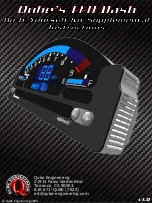
Supervision Failure Indications: If a supervision failure
occurs, it will be indicated by the appropriate LED flashing 2
times per second, regardless of the LED enable/disable option
chosen by DIP Switch. If a PIR failure occurs, the RED LED
will flash; if a microwave failure occurs, the GREEN LED will
flash. If the unit has defaulted to PIR-only operation as a
result of a microwave failure, the RED LED will light when an
alarm occurs, if enabled by DIP Switch while the GREEN LED
continues to flash.
Upon supervision failure, the open collector TROUBLE output
on the terminal block will also go low (requires 1000-ohm pull-
up resistor). Use shielded wire for UL installations.
TO THE INSTALLER
Regular maintenance and inspection (at least annually) by the
installer and frequent testing by the user are vital to
continuous satisfactory operation of any alarm system.
The installer should assume the responsibility of developing and
offering a regular maintenance program to the user, as well as
acquainting the user with the proper operation and limitations
of the alarm system and its component parts. Recommendations
must be included for a specific program of frequent testing (at
least weekly) to ensure the system’s operation at all times.
MAINTAINING PROPER OPERATION
In order to maintain the detector in proper working condition,
it is important that the following be observed by the user:
1. Power should be provided at all times. Loss of power to the
unit will result in the alarm contacts reverting to an alarm
state. The unit’s DC source should have standby power
available for at least 4 hours of operation during
emergencies.
2. Units should never be re-aimed or relocated without the
advice or assistance of the alarm service company.
3. The physical surroundings of the protected area should not
be changed. If furniture or stock is moved, or air
conditioning or additional heating is installed, the system
may have to be readjusted by the alarm service company.
4. Walk-Tests should be conducted frequently (at least
weekly) to confirm proper coverage by each detector.
FEDERAL COMMUNICATIONS COMMISSION (FCC)
STATEMENT
This device complies with Part 15 of FCC Rules. Operation is
subject to the following two conditions: (1) This device may not
cause harmful interference, and (2) This device must accept
any interference received, including interference that may
cause undesired operation.
WARNING
THE LIMITATIONS OF YOUR MICROWAVE/PASSlVE
INFRARED MOTION DETECTOR
While the Intrusion Detector is a highly reliable intrusion detection device, it does not
offer guaranteed protection against burglary. Any Intrusion Detection device is
subject to compromise or failure to warn for a variety of reasons:
•
These Motion Detectors can only detect intrusion within the designed ranges as
diagrammed in this installation manual.
•
The passive infrared motion sensor in this Motion Dectector do not provide
volumetric area protection. It does create multiple beams of protection, and
intrusion can only be detected in unobstructed areas covered by those beams.
•
Passive Infrared Detectors cannot detect motion or intrusion that takes place behind
walls, ceilings, floors, closed doors, glass partitions, glass doors, or windows.
• Metal objects (or other reflectors, such as foil faced insulation or water in bottles)
can alter the microwave sensors protection pattern.
• Mechanical tampering, masking, painting or spraying of any material on the
mirrors, windows or any part of the optical system can reduce the detection ability
of the Passive Infrared Motion Detector.
•
Passive Infrared Detectors sense changes in temperature; however, as the
ambient temperature of the protected area approaches the temperature range of
90° to 105°F (32° to 40°C), the detection performance can decrease.
•
This Passive Infrared Detector will not operate without appropriate DC power connected
to it or if the DC power is improperly connected (i.e. reversed polarity connections).
•
Passive Infrared Detectors, like other electrical devices, are subject to component
failure. Even though they are designed to last as long as 10 years, the electronic
components could fail at any time.
We have cited some of the most common reasons that a Passive Infrared Motion Detector
can fail to catch intrusion. However, this does not imply that these are the only reasons and
therefore, it is recommended that weekly testing of this type of unit, in conjunction with
weekly testing of the entire alarm system, be performed to ensure that the detectors are
working properly.
Installing an alarm system may make the owner eligible for a lower insurance rate,
but an alarm system is not a substitute for insurance. Homeowners, property owners
and renters should continue to act prudently in protecting themselves and continue
to insure their lives and property.
We continue to develop new and improved protection devices. Users of alarm systems
owe it to themselves and their loved ones to learn about these developments.
ADEMCO LIMITED WARRANTY
Alarm Device Manufacturing Company, a Division of Pittway Corporation, and its
divisions, subsidiaries and affiliates ("Seller"), 165 Eileen Way, Syosset, New York
11791, warrants this detector to be in conformance with its own plans and
specifications and to be free from defects in materials and workmanship under
normal use and service for 72 months from the date stamp control on the product.
Seller's obligation shall be limited to replacing, at its option, free of charge for
materials or labor, a detector which is proved not in compliance with Seller's
specifications or proves defective in materials or workmanship under normal use
and service. Seller shall have no obligation under this Limited Warranty or other-
wise if the detector is altered or improperly repaired or serviced by anyone other
than Ademco factory service. In case of defect, return the detector to ADI or an
authorized distributor for an immediate replacement.
THERE ARE NO WARRANTIES, EXPRESS OR IMPLIED, OF
MERCHANTABILITY, OR FITNESS FOR A PARTICULAR PURPOSE OR
OTHERWISE, WHICH EXTEND BEYOND THE DESCRIPTION ON THE FACE
HEREOF. IN NO CASE SHALL SELLER BE LIABLE TO ANYONE FOR ANY
CONSEQUENTIAL OR INCIDENTAL DAMAGES FOR BREACH OF THIS OR
ANY OTHER WARRANTY, EXPRESS OR IMPLIED, OR UPON ANY OTHER
BASIS OF LIABILITY WHATSOEVER, EVEN IF THE LOSS OR DAMAGE IS
CAUSED BY THE SELLER'S OWN NEGLIGENCE OR FAULT.
Seller does not represent that its detector may not be compromised or cir-
cumvented; that the detector will prevent any personal injury or property loss by
burglary, robbery, fire or otherwise; or that the detector will in all cases provide
adequate warning or protection. Buyer understands that a properly installed and
maintained alarm may only reduce the risk of a burglary, robbery, fire or other
events occurring without providing an alarm, but it is not insurance or a guarantee
that such will not occur or that there will be no personal injury or property loss as
a result. CONSEQUENTLY, SELLER SHALL HAVE NO LIABILITY FOR ANY
PERSONAL INJURY, PROPERTY DAMAGE OR OTHER LOSS BASED ON A
CLAIM THE DETECTOR FAILED TO GIVE WARNING. HOWEVER, IF SELLER
IS HELD LIABLE, WHETHER DIRECTLY OR INDIRECTLY, FOR ANY LOSS OR
DAMAGE ARISING UNDER THIS LIMITED WARRANTY OR OTHERWISE, RE-
GARDLESS OF CAUSE OR ORIGIN, SELLER'S MAXIMUM LIABILITY SHALL
NOT IN ANY CASE EXCEED THE PURCHASE PRICE OF THE DETECTOR,
WHICH SHALL BE THE COMPLETE AND EXCLUSIVE REMEDY AGAINST
SELLER. This warranty replaces any previous warranties and is the only warranty
made by Seller on this detector. No increase or alteration, written or verbal, of the
obligations of this Limited Warranty is authorized.
N8656V1 12/98
165 Eileen Way, Syosset, New York 11791
Copyright © 1998 PITTWAY CORPORATION
ÊN8656V1m






















